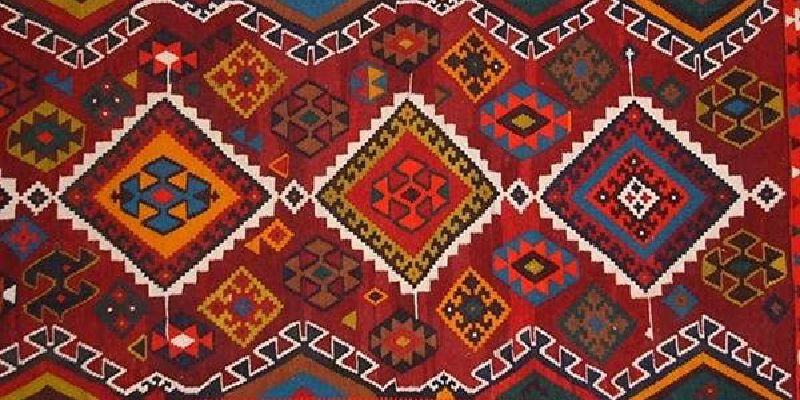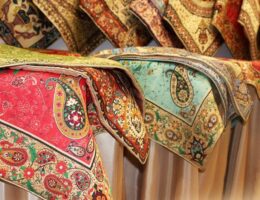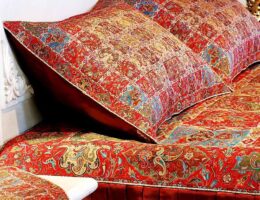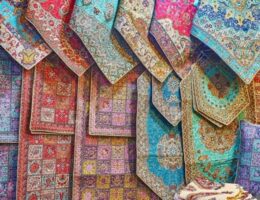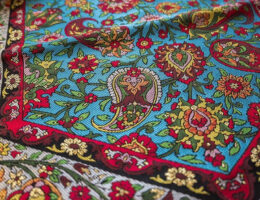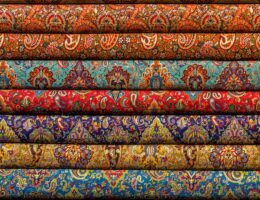IRAN ART EXHIBITION: KILIM IS USED IN MANY PERSIAN HANDICRAFTS, NOT JUST RUGS
kilim
Kilim is a flat tapestry-woven carpet or rug traditionally produced in countries of the former Persian empire, including Iran, Azerbaijan, the Balkans and the Turkic countries of central Asia.
Kilims can be purely decorative or can function as prayer rugs. Modern kilims are popular floor coverings in Western households.
What is kilim?
In general, a kilim is a carpet with a smooth texture or a type of carpet without lint or sleep. The name of kilim is given in different languages, with different types. Also, flat weaving is found all over the world, from the United States to Scandinavia and Indonesia.
The kilim, in its traditional form, is commonly used to cover floors, walls, or bedspreads for pets, in some cases kilim furniture is popular, but is now also purchased as a modern cover for townhouses.
Antique kilim rugs are popular all over the world. Turkish kilim rugs, Persian kilim rugs, kilim rugs UK are the most famous of kilim rugs all over the world.
Sometimes there are similarities in the texture of these products. But the order that results from the materials and techniques of the work often leads to obvious similarities in roles.
Although the past few decades carpet, woven by nomadic Nazli was seen, todays tendency for people due to aspects for which the products are, we are, therefore, has a variety of products around the world, his fans have it.
What is rug?
A rug is a simple hand-woven yarn (cotton or wool) and weft (wool) that is usually woven from the wool of domestic animals. Each area has its design and is generally used as a rug.
History and background of kilim and kilim weaving
The history of kilims goes back to ancient times. It can almost be said that kilim weaving is one of the first arts and human handicrafts. It should understand that it is not clear the first time where and by what tribe woven, but in the meantime documents by archaeologists collected shows that the effects of raising goats And sheep and spinning their wool and hair on the plateau of Iran and places such as caves in southeastern Mazandaran (near the modern city) were common eight thousand years ago.
An 8,000-year-old piece of cloth woven from goat hair has also been discovered in the area. However, with all the documents, it is not possible to find an exact date for the weaving of the first rug, but despite the oldest carpet discovered in the world, which is called Pazyryk, it belongs to the years 350 to 500 AH.
The reason why the original kilims did not remain is that these products do not have a long life like the stone industry leftover from 2000 years ago, in other words, they are more prone to erosion. With all these statements, according to experts and conclusions that can be drawn, it is said that before the weaving of the carpet, it was the weaving of the rug, but the probable date of the beginning of the weaving of the kilim dates back to 3000 to 5000 BC.
Difference between kilim and Persian jajim
IRAN ART EXHIBITION: It is important to know that kilim is different from Zillow and Jajim. kilim or palus is a type of underlayment and covering that is woven from silk, goat hair, fleece, or other domestic animals.
The difference between kilim and Jajim
Jajim weaving fibers are colored and are effective in their pattern. Also, the number of chel jajim is more and more delicate than kilim.
• Cheleh fibers are visible in Jajim and have a great impact on its beauty. But cheleh is not visible in the kilim.
• In Jajim weaving, several long pieces are woven like ribbon and then joined together. But in kilims, the whole dimensions of the kilim are woven in one place.
• Jajim shapes and motifs are created by warp and weft and are usually vertical and horizontal. But in kilims, design limitations have been reduced.
• The kilim is usually thicker than the jajim.
Kilim raw materials
From ancient times, this beautiful weave was woven with cream wool yarns obtained from sheep wool or goat hair. After a while, cotton yarn was added to the weave of kilim, and today, sometimes with synthetic yarns such as acrylic, Chrome and aniline are also woven. Also, dyes made in traditional types have always been natural, but today chemical materials and dyes are also used.
The designs used in these types of weaves are generally geometric patterns that have different shapes, such as triangles, rhombuses, hexagons, and rectangles.
Of course, many original and traditional motifs adorn the face of Iranian kilims, which sometimes take the form of animals and nature, and sometimes cashmere, flowers, and plants. The different designs used in these arts depend on the type and area in which they are woven.
Types of kilims
Iranian kilims can be divided into three groups:
• Flat Kilim
• Sumak Kilim
• Special kilims or one-sided but non-sumac kilims
• Simple or double or flat kilims
Products simple or double beds for the texture of the method Pvdgzary used. It is less thick compared to other types of gilims. The drawings on both sides of the kilim are the same and finally, its two sides (back and front) can be used.
Qashqai kilims, Saneh and Bijar kilims in Kurdistan and Musnad and simple kilims in Ardabil, Semnan, Zanjan kilims, etc. are in this group. This type of kilim has only warp and weft.
In weaving this type of gilims, simple kilim weaving methods, somak kilim weaving (screw weaving), and even in some cases, in some cases, carpet weaving method (full knot) is used.
The embossed flower kilims of Ilam, Gochmeh in Kohgiluyeh and Boyer-Ahmad provinces, Shurki which is woven in Khorasan province and about 50 km from Mashhad city, Rezaabad Khartouran kilim which is woven about 320 km in Shahroud, the Kurdish tablecloth kilim of Khorasan and … It falls into this category.
kilim weaving steps and methods
The steps of weaving a kilim
Such as carpet after the establishment of the tissue products different stages during which they will be familiar with the following brief:
• Twisting: The first step is to knit, during which two ropes of the desired size are tied parallel to the underlay, which is called a string, and the beginning of the cotton thread is tied to the last left or right part of the underlay The cotton yarn is then passed through the back of the first gutter and in front of the second gutter and carried from the top of the gill to the back and out of the lower part.
• Koji wood closure: It is a cylindrical wood that is usually 4 cm in diameter and the width of the machine.
• Fixing the wefts: Because they are used during weaving to increase the density and compress the wefts, the wefts must be tightened so that they do not move and the shape of the kilim does not collapse To do this, they usually rub a little glue on the cheeks.
• Chain weaving: This is usually done before weaving to speed up the weaving.
Iranian kilim weaving methods
Two methods have been defined for weaving Iranian kilims :
• Weaving method: In this method, only weft yarn and warp or weft yarn are used for weaving, in such a way that the colored weft yarns pass through the bottom and top of the warp yarns, and by changing the color of the wefts, different roles They appear on the work and thus it becomes smooth and one color under and on it.
• Screw weaving method: To weave the kilim, the artists use another thin weft in addition to the warp and weft yarns, in such a way that the wefts pass through the middle of the wefts and then the thin weft passes through them. And beat it with a shoulder and one hand. This method, which is similar to carpet weaving, is known as the connection point of kilim weaving to the emergence of carpet weaving art.
Kilim and kilim weaving in different regions of Iran
• Baluchi
• Hersin
• Qashqai
• sene
• Turkmen
• Zarandi
• Afshari
Uses of kilims
IRAN ART EXHIBITION: In addition to being used as underlays and decorative items, there are other uses for kilims, which we will provide you with a brief explanation on this subject:
Salt shaker: It is interesting to know that one of the uses of kilims is to store salt and other materials that are sensitive to moisture. This type of kilim is woven in such a way that the upper part of it is long and narrow and it can be wrapped or folded to keep its contents intact.
Khorjin: Since a large part of the kilim weaving done in the country is done by nomads, these tribes use this product in various ways.
One of these uses of the kilim as an expense is that it takes the form of a double bag and is used to carry vegetable food, etc., which is usually placed on the back of a donkey or camel for easy transportation. Be wet.
Tablecloths and chairs: This type of kilim is mostly woven by the Baluch and Kurdish tribes of the country and is square. The tablecloths that Baluchis weave are woven similar to carpets, but their dimensions are different.
Also, the chair used for the fireplace in the cold seasons can retain a lot of heat and create a warm atmosphere for the whole family by using the felts that are spread around it. Also, another use of the kilim on the chair is that it is used to cover the brazier or oven.
Sajjadeh gilim: This type of kilim usually has very beautiful roles and is a small and portable altar that can be spread during prayers and prayers can be performed on it. This type of kilim is also used in some cases as curtains and decorations for mosque doors.
Jawal: Jawal is a large bag, also known as a tuber or turba, these bags are usually hung on the wall and used to hold it.
mafrash: Exercise is used to close furniture and household items such as bedding and other items that are necessary for life and travel. Ino Green is currently only found in nomadic tribes that are still migrating.
Ency: This important sampling is a type of rug that is used to tie furniture.

Chiq: This type of kilim, which is in the category of simple kilims, is used for the walls of nomadic tents. The back and front of these kilims are similar and their designs are simple and old.
Jul: Jul is a type of kilim that is woven by needle method. It is mostly used for sweating cattle.
Musnad: This type of kilim is mostly woven by nomads in Ardabil, it is not very old and it has only been in the field of kilim for about 50 years. An important feature of the chair is its beautiful designs and high elegance, which makes it more decorative.
Palace or Plus: The appearance of Plus is similar to a simple kilim, the yarn, and fabric used in it are made of cotton and it is mostly woven around Yazd.
Zillow: Zillow, which falls under another category and is usually woven in rural areas with cotton thread, is a great option for underlayment in summer. Today, zillows are woven in two traditional ways and with a machine. The traditional method is more common in villages and of course, it is thicker and has less color variety than machine models.
Glimche: As its name suggests, Glimche is the same kilim in smaller dimensions that are woven in the same way. Another difference between this product and Grimm is that the variety of colors and roles in them is more and also today it has been able to attract many customers.
The price of kilims
The price of kilims varies in different parts of the country because they are woven in different regions with different methods and raw materials. But in general, some factors increase the price of kilims, some of which are:
• Delicacy
• Engraving
• Variety of colors
• Age or date of rug
• Dimensions of the kilim
• Weaving method and quality of kilim
IRAN ART EXHIBITION: In the end, we can say that kilim has lots of various that you can find your favorite type. Kilim can be used in different stuffs like bag, pencil case, etc. but mostly it used as carpet. You can find different type of kilim in different country.
